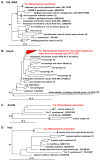Enrichment and genome sequence of the group I.1a ammonia-oxidizing Archaeon "Ca. Nitrosotenuis uzonensis" representing a clade globally distributed in thermal habitats
- PMID: 24278328
- PMCID: PMC3835317
- DOI: 10.1371/journal.pone.0080835
Enrichment and genome sequence of the group I.1a ammonia-oxidizing Archaeon "Ca. Nitrosotenuis uzonensis" representing a clade globally distributed in thermal habitats
Abstract
The discovery of ammonia-oxidizing archaea (AOA) of the phylum Thaumarchaeota and the high abundance of archaeal ammonia monooxygenase subunit A encoding gene sequences in many environments have extended our perception of nitrifying microbial communities. Moreover, AOA are the only aerobic ammonia oxidizers known to be active in geothermal environments. Molecular data indicate that in many globally distributed terrestrial high-temperature habits a thaumarchaeotal lineage within the Nitrosopumilus cluster (also called "marine" group I.1a) thrives, but these microbes have neither been isolated from these systems nor functionally characterized in situ yet. In this study, we report on the enrichment and genomic characterization of a representative of this lineage from a thermal spring in Kamchatka. This thaumarchaeote, provisionally classified as "Candidatus Nitrosotenuis uzonensis", is a moderately thermophilic, non-halophilic, chemolithoautotrophic ammonia oxidizer. The nearly complete genome sequence (assembled into a single scaffold) of this AOA confirmed the presence of the typical thaumarchaeotal pathways for ammonia oxidation and carbon fixation, and indicated its ability to produce coenzyme F420 and to chemotactically react to its environment. Interestingly, like members of the genus Nitrosoarchaeum, "Candidatus N. uzonensis" also possesses a putative artubulin-encoding gene. Genome comparisons to related AOA with available genome sequences confirmed that the newly cultured AOA has an average nucleotide identity far below the species threshold and revealed a substantial degree of genomic plasticity with unique genomic regions in "Ca. N. uzonensis", which potentially include genetic determinants of ecological niche differentiation.
Conflict of interest statement
Figures



Similar articles
-
A mesophilic, autotrophic, ammonia-oxidizing archaeon of thaumarchaeal group I.1a cultivated from a deep oligotrophic soil horizon.Appl Environ Microbiol. 2014 Jun;80(12):3645-55. doi: 10.1128/AEM.03730-13. Appl Environ Microbiol. 2014. PMID: 24705324 Free PMC article.
-
"Candidatus Nitrosotenuis aquarius," an Ammonia-Oxidizing Archaeon from a Freshwater Aquarium Biofilter.Appl Environ Microbiol. 2018 Sep 17;84(19):e01430-18. doi: 10.1128/AEM.01430-18. Print 2018 Oct 1. Appl Environ Microbiol. 2018. PMID: 29959256 Free PMC article.
-
Membrane Lipid Composition of the Moderately Thermophilic Ammonia-Oxidizing Archaeon "Candidatus Nitrosotenuis uzonensis" at Different Growth Temperatures.Appl Environ Microbiol. 2019 Oct 1;85(20):e01332-19. doi: 10.1128/AEM.01332-19. Print 2019 Oct 15. Appl Environ Microbiol. 2019. PMID: 31420340 Free PMC article.
-
The Thaumarchaeota: an emerging view of their phylogeny and ecophysiology.Curr Opin Microbiol. 2011 Jun;14(3):300-6. doi: 10.1016/j.mib.2011.04.007. Epub 2011 May 4. Curr Opin Microbiol. 2011. PMID: 21546306 Free PMC article. Review.
-
Diversity, physiology, and niche differentiation of ammonia-oxidizing archaea.Appl Environ Microbiol. 2012 Nov;78(21):7501-10. doi: 10.1128/AEM.01960-12. Epub 2012 Aug 24. Appl Environ Microbiol. 2012. PMID: 22923400 Free PMC article. Review.
Cited by
-
Chemoautotrophic growth of ammonia-oxidizing Thaumarchaeota enriched from a pelagic redox gradient in the Baltic Sea.Front Microbiol. 2015 Jan 15;5:786. doi: 10.3389/fmicb.2014.00786. eCollection 2014. Front Microbiol. 2015. PMID: 25642221 Free PMC article.
-
Niche breadth specialization impacts ecological and evolutionary adaptation following environmental change.ISME J. 2024 Jan 8;18(1):wrae183. doi: 10.1093/ismejo/wrae183. ISME J. 2024. PMID: 39325971 Free PMC article.
-
Microbial diversity of hot springs of the Kuril Islands.BMC Microbiol. 2024 Dec 28;24(1):547. doi: 10.1186/s12866-024-03704-8. BMC Microbiol. 2024. PMID: 39732654 Free PMC article.
-
Microbial diversity and autotrophic activity in Kamchatka hot springs.Extremophiles. 2017 Mar;21(2):307-317. doi: 10.1007/s00792-016-0903-1. Epub 2016 Dec 27. Extremophiles. 2017. PMID: 28028613
-
Inhibitory effects of C2 to C10 1-alkynes on ammonia oxidation in two Nitrososphaera species.Appl Environ Microbiol. 2015 Mar;81(6):1942-8. doi: 10.1128/AEM.03688-14. Epub 2015 Jan 9. Appl Environ Microbiol. 2015. PMID: 25576608 Free PMC article.
References
Publication types
MeSH terms
Substances
LinkOut - more resources
Full Text Sources
Other Literature Sources

